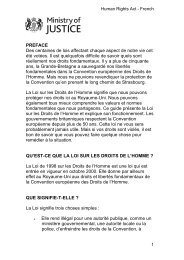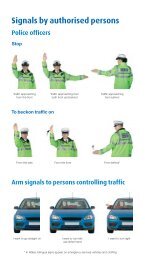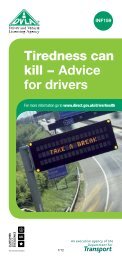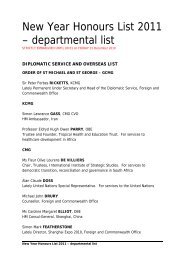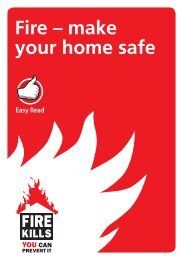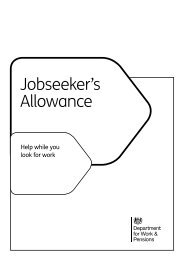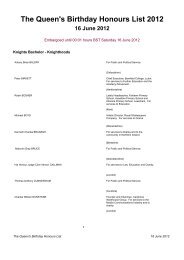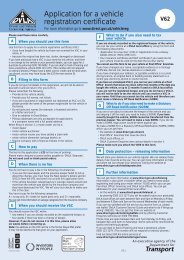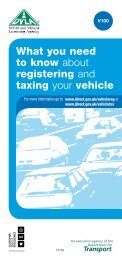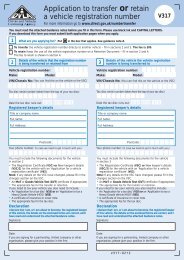Large Vehicles you can drive using your car or lorry licence - DVLA
Large Vehicles you can drive using your car or lorry licence - DVLA
Large Vehicles you can drive using your car or lorry licence - DVLA
You also want an ePaper? Increase the reach of your titles
YUMPU automatically turns print PDFs into web optimized ePapers that Google loves.
INF52<br />
<strong>Large</strong> <strong>Vehicles</strong><br />
<strong>you</strong> <strong>can</strong> <strong>drive</strong><br />
<strong>using</strong> <strong>you</strong>r <strong>car</strong><br />
<strong>or</strong> l<strong>or</strong>ry <strong>licence</strong><br />
F<strong>or</strong> m<strong>or</strong>e inf<strong>or</strong>mation go to www.direct.gov.uk/driving<br />
7/11
Contents<br />
Inf<strong>or</strong>mation leaflets ............................................... 2<br />
Goods vehicles that <strong>can</strong> be <strong>drive</strong>n<br />
with a full categ<strong>or</strong>y B <strong>licence</strong> ............................... 3<br />
Buses that <strong>can</strong> be <strong>drive</strong>n with a<br />
full categ<strong>or</strong>y B <strong>licence</strong> .......................................... 5<br />
Buses that <strong>can</strong> be <strong>drive</strong>n with a<br />
full categ<strong>or</strong>y C <strong>licence</strong> ......................................... 5<br />
Minimum ages ...................................................... 6<br />
Descriptions of vehicle categ<strong>or</strong>ies ....................... 6<br />
How are vehicles classed? ................................... 8<br />
Imp<strong>or</strong>tant inf<strong>or</strong>mation, please read <strong>car</strong>efully<br />
This leaflet explains that <strong>you</strong> <strong>can</strong> <strong>drive</strong> large<br />
vehicles <strong>or</strong> buses <strong>using</strong> <strong>you</strong>r l<strong>or</strong>ry (LGV) <strong>or</strong> <strong>car</strong><br />
driving <strong>licence</strong>.<br />
Please note:<br />
All professional bus, coach and l<strong>or</strong>ry <strong>drive</strong>rs must hold a<br />
<strong>drive</strong>r Certificate of Professional Competence (CPC) as well<br />
as their vocational driving <strong>licence</strong>. F<strong>or</strong> m<strong>or</strong>e advice, phone<br />
the Driving Standards Agency on 0300 200 1122 <strong>or</strong> send an<br />
email to <strong>drive</strong>rcpc@dsa.gsi.gov.uk<br />
Inf<strong>or</strong>mation leaflets<br />
We produce other leaflets dealing with minibuses, trailers,<br />
MoTs and heavy goods vehicle tests, and driving in GB as<br />
a visit<strong>or</strong> <strong>or</strong> new resident. You <strong>can</strong> download these from the<br />
website at www.direct.gov.uk/mot<strong>or</strong>ingleaflets <strong>or</strong> <strong>or</strong>der<br />
copies by phoning 0300 790 6801.<br />
19249<br />
2
Goods vehicles that <strong>can</strong> be <strong>drive</strong>n<br />
with a full categ<strong>or</strong>y B <strong>licence</strong><br />
If <strong>you</strong> hold a full categ<strong>or</strong>y B driving <strong>licence</strong> <strong>you</strong> <strong>can</strong> <strong>drive</strong><br />
any of the following large vehicles, known as ‘exempted’<br />
goods vehicles.<br />
• Goods vehicles powered by steam (f<strong>or</strong> example, large<br />
vehicles with coal <strong>or</strong> wood-burning engines).<br />
• Any road construction vehicles used <strong>or</strong> kept on the road<br />
f<strong>or</strong> <strong>car</strong>rying built-in road construction machinery (with <strong>or</strong><br />
without the materials used by that machinery).<br />
• Any engineering equipment (vehicles designed <strong>or</strong> built f<strong>or</strong> the<br />
purpose of engineering w<strong>or</strong>k), except mobile cranes.<br />
• A w<strong>or</strong>ks truck designed f<strong>or</strong> use on private property<br />
<strong>or</strong> in the immediate area around it (f<strong>or</strong> example, trucks<br />
and f<strong>or</strong>klift trucks).<br />
• Industrial tract<strong>or</strong>s (tract<strong>or</strong>s used mainly f<strong>or</strong> haulage w<strong>or</strong>k<br />
off the public road) with a weight of no m<strong>or</strong>e than 7370kg<br />
when loaded, and designed to travel no faster than 20mph.<br />
• Agricultural mot<strong>or</strong> vehicles which are used off the road<br />
and are not tract<strong>or</strong>s (f<strong>or</strong> example, crop sprayers and<br />
combine harvesters).<br />
• Digging machines (vehicles with digging buckets<br />
<strong>or</strong> shovels) which travel on a public road only f<strong>or</strong> the<br />
purpose of going to <strong>or</strong> from a site where they are used f<strong>or</strong><br />
digging <strong>or</strong> shovelling w<strong>or</strong>k.<br />
• Goods vehicles which are:<br />
- used on the public road only to move between land<br />
owned <strong>or</strong> used by the person keeping the vehicle, and<br />
- not used on public roads f<strong>or</strong> distances of m<strong>or</strong>e than<br />
9.7 kilometres in total during any week (midnight on<br />
Saturday to midnight on the following Saturday).<br />
• Goods vehicles, other than agricultural mot<strong>or</strong><br />
vehicles, which:<br />
- are used only f<strong>or</strong> agriculture, h<strong>or</strong>ticulture<br />
<strong>or</strong> f<strong>or</strong>estry purposes<br />
- are used on roads only to move between land owned<br />
<strong>or</strong> used by the keeper of the vehicle, and<br />
- do not travel m<strong>or</strong>e than 1.5 kilometres on roads<br />
at one time.<br />
• Goods vehicles used f<strong>or</strong> no purpose other than moving<br />
lifeboats and the necessary gear of the lifeboats.<br />
• Goods vehicles built bef<strong>or</strong>e 1 January 1960, as long as<br />
they are not loaded and are not towing a loaded trailer.<br />
• Articulated goods vehicles weighing less than 3.05 tonnes<br />
when not loaded.<br />
3
• Goods vehicles being used by a visiting armed f<strong>or</strong>ce<br />
<strong>or</strong> headquarters (as defined in the Visiting F<strong>or</strong>ces and<br />
International Headquarters (Application of Law) Order<br />
1965(a)).<br />
• Goods vehicles <strong>drive</strong>n by a police officer f<strong>or</strong> the purpose of:<br />
- stopping the vehicle obstructing road users <strong>or</strong> other<br />
members of the public, <strong>or</strong><br />
- protecting life <strong>or</strong> property (including the vehicle and its<br />
load), <strong>or</strong> f<strong>or</strong> similar purposes.<br />
• Goods vehicles fitted with equipment designed f<strong>or</strong> partly<br />
raising a broken-down <strong>or</strong> disabled vehicle (one that<br />
<strong>can</strong>not be <strong>drive</strong>n) from the ground and towing it, as long<br />
as the goods vehicles:<br />
- are only used f<strong>or</strong> dealing with broken-down <strong>or</strong><br />
disabled vehicles<br />
- are not used f<strong>or</strong> <strong>car</strong>rying any goods other than<br />
broken-down <strong>or</strong> disabled vehicles and items needed<br />
to deal with broken-down <strong>or</strong> disabled vehicles, and<br />
- weigh no m<strong>or</strong>e than 3.05 tonnes when not loaded.<br />
• A bus recovery vehicle. A bus recovery vehicle is a vehicle<br />
(not being an articulated goods vehicle) which:<br />
- has an unloaded weight of no m<strong>or</strong>e than 10.2 tonnes<br />
- is being <strong>drive</strong>n by the holder of a PSV operat<strong>or</strong>’s<br />
<strong>licence</strong>, and<br />
- is being used f<strong>or</strong> the purpose of:<br />
- going to, <strong>or</strong> returning from, a place where help will<br />
<strong>or</strong> has been given to a damaged <strong>or</strong> broken-down<br />
bus, <strong>or</strong><br />
- trying to repair <strong>or</strong> moving a broken-down bus, <strong>or</strong><br />
moving a damaged vehicle.<br />
Note: Bus recovery vehicles <strong>can</strong> also be <strong>drive</strong>n with full<br />
categ<strong>or</strong>y D entitlement.<br />
• Mobile project vehicles. A vehicle which has a<br />
Maximum Auth<strong>or</strong>ised Mass (MAM) exceeding 3.5 tonnes,<br />
whose primary purpose is to be used as a recreational,<br />
educational <strong>or</strong> instructional facility when stationary, <strong>car</strong>rying:<br />
- mainly goods <strong>or</strong> burden consisting of play <strong>or</strong><br />
educational equipment and articles required in<br />
connection with the use of such equipment, <strong>or</strong><br />
- articles required f<strong>or</strong> the purpose of display <strong>or</strong> of<br />
an exhibition.<br />
The vehicle must be constructed <strong>or</strong> adapted to <strong>car</strong>ry not<br />
m<strong>or</strong>e than eight persons in addition to the <strong>drive</strong>r.<br />
4
You must be aged 21 and have held a categ<strong>or</strong>y B <strong>licence</strong> f<strong>or</strong><br />
at least two years. A mobile project vehicle may only be <strong>drive</strong>n<br />
on behalf of a non-commercial <strong>or</strong>ganisation. If a <strong>drive</strong>r passes<br />
a (categ<strong>or</strong>y B) <strong>car</strong> test bef<strong>or</strong>e 1 January 1997 they may be<br />
able to <strong>drive</strong> the vehicle commercially.<br />
Mobile cranes<br />
Since 1 January 1999, a categ<strong>or</strong>y C1 driving <strong>licence</strong> is<br />
needed to <strong>drive</strong> a mobile crane which weighs between<br />
3.5 tonnes and 7.5 tonnes, and categ<strong>or</strong>y C if the crane<br />
weighs over 7.5 tonnes.<br />
Buses that <strong>can</strong> be <strong>drive</strong>n with a full<br />
categ<strong>or</strong>y B <strong>licence</strong><br />
If <strong>you</strong> hold a full categ<strong>or</strong>y B driving <strong>licence</strong> <strong>you</strong> <strong>can</strong> <strong>drive</strong><br />
any of the following vehicles (known as exempted<br />
passenger-<strong>car</strong>rying vehicles).<br />
• A bus made m<strong>or</strong>e than 30 years bef<strong>or</strong>e the date it is<br />
being <strong>drive</strong>n, and not used f<strong>or</strong> business purposes <strong>or</strong> f<strong>or</strong><br />
<strong>car</strong>rying m<strong>or</strong>e than eight passengers.<br />
• A minibus with up to 16 passenger seats, as long as:<br />
- the vehicle is used f<strong>or</strong> social purposes by a<br />
non-commercial <strong>or</strong>ganisation, but not f<strong>or</strong> hire<br />
<strong>or</strong> reward (that is, not to make a profit)<br />
- the <strong>drive</strong>r is at least 21<br />
- the <strong>drive</strong>r has held a <strong>car</strong> (categ<strong>or</strong>y B) <strong>licence</strong> f<strong>or</strong><br />
at least two years<br />
- the <strong>drive</strong>r has volunteered to <strong>drive</strong><br />
- the maximum weight of the minibus is not m<strong>or</strong>e than<br />
3.5 tonnes (<strong>or</strong> 4.25 tonnes including any specialist<br />
equipment f<strong>or</strong> <strong>car</strong>rying disabled passengers), and<br />
- if the <strong>drive</strong>r is 70 <strong>or</strong> over, he <strong>or</strong> she <strong>can</strong> meet the health<br />
standards f<strong>or</strong> driving a minibus (categ<strong>or</strong>y D1).<br />
Buses that <strong>can</strong> be <strong>drive</strong>n with<br />
a full categ<strong>or</strong>y C <strong>licence</strong><br />
If <strong>you</strong> hold a full categ<strong>or</strong>y C (LGV) driving <strong>licence</strong> <strong>you</strong><br />
<strong>can</strong> also <strong>drive</strong> large buses as long as <strong>you</strong> have held<br />
the <strong>licence</strong> f<strong>or</strong> at least two years and the vehicle is:<br />
• damaged <strong>or</strong> faulty and being <strong>drive</strong>n to a place to be<br />
repaired, <strong>or</strong> is being road-tested after repair, and<br />
• is not used f<strong>or</strong> <strong>car</strong>rying any person who is not connected<br />
with repairing <strong>or</strong> road-testing it.<br />
5
Minimum ages<br />
The minimum age f<strong>or</strong> driving an exempted goods<br />
vehicle depends on its weight.<br />
• <strong>Vehicles</strong> with a MAM of m<strong>or</strong>e than 3.5 tonnes but less<br />
than 7.5 tonnes may be <strong>drive</strong>n from the age of 18.<br />
• <strong>Vehicles</strong> which weigh m<strong>or</strong>e than 7.5 tonnes <strong>can</strong> be <strong>drive</strong>n<br />
from the age of 21.<br />
• The minimum age f<strong>or</strong> driving an exempted<br />
passenger-<strong>car</strong>rying vehicle is 18.<br />
Descriptions of vehicle categ<strong>or</strong>ies<br />
Categ<strong>or</strong>y Description Minimum<br />
age<br />
B Cars<br />
Mot<strong>or</strong> vehicles with a MAM of up to<br />
3,500kg, no m<strong>or</strong>e than eight passenger<br />
seats, with <strong>or</strong> without a trailer weighing<br />
up to 750kg.<br />
If the <strong>car</strong> is with a trailer weighing m<strong>or</strong>e<br />
than 750kg, the total weight of the vehicle<br />
and the trailer together <strong>can</strong>’t be m<strong>or</strong>e than<br />
3,500kg. The weight of the trailer, when<br />
fully loaded, <strong>can</strong>’t weigh m<strong>or</strong>e than the<br />
weight of the vehicle when it is not loaded<br />
and has no passengers.<br />
C1 Medium sized vehicles<br />
<strong>Vehicles</strong> weighing between 3,500kg and<br />
7,500kg, with <strong>or</strong> without a trailer weighing<br />
up to 750kg.<br />
C <strong>Large</strong> vehicles<br />
<strong>Vehicles</strong> over 3,500kg with a trailer<br />
weighing up to 750kg.<br />
D1 Minibuses<br />
D Buses<br />
<strong>Vehicles</strong> with 9 to 16 passenger seats,<br />
with <strong>or</strong> without a trailer weighing up to<br />
750kg.<br />
Any bus with m<strong>or</strong>e than eight passenger<br />
seats, with a trailer up to 750kg.<br />
6<br />
17<br />
Notes<br />
that<br />
apply<br />
18 Note 4<br />
21 Note 1<br />
21 Notes<br />
2 and 4<br />
21 Notes<br />
2 and 3
Note 1<br />
You <strong>can</strong> <strong>drive</strong> at 17 if <strong>you</strong> are a member of the armed services.<br />
You <strong>can</strong> <strong>drive</strong> at 18 if:<br />
• <strong>you</strong> have passed <strong>you</strong>r driving test and Driver CPC initial<br />
qualification<br />
• <strong>you</strong> are learning to <strong>drive</strong> <strong>or</strong> taking a driving test f<strong>or</strong> this<br />
categ<strong>or</strong>y <strong>or</strong> the Driver CPC initial qualification<br />
• <strong>you</strong> are taking a national vocational training course to get<br />
the Driver CPC initial qualification, <strong>or</strong><br />
• <strong>you</strong> got <strong>you</strong>r driving <strong>licence</strong> bef<strong>or</strong>e 10 September 2009 (in<br />
which case <strong>you</strong> must take the CPC periodic training within<br />
five years of the date <strong>you</strong> got <strong>you</strong>r driving <strong>licence</strong>).<br />
Note 2<br />
You <strong>can</strong> <strong>drive</strong> at age 17 if <strong>you</strong> are a member of the armed<br />
services.<br />
You <strong>can</strong> <strong>drive</strong> these vehicles at age 18 if one of the following<br />
apply:<br />
i) You are learning to <strong>drive</strong> <strong>or</strong> taking a PCV test <strong>or</strong> Driver CPC<br />
initial qualification.<br />
ii) Having passed a PCV driving test and Driver CPC initial<br />
qualification, <strong>you</strong> <strong>can</strong> <strong>drive</strong> under any of the following conditions:<br />
• driving on a regular service where the route doesn’t<br />
exceed 50km<br />
• not engaged in the <strong>car</strong>riage of passengers, <strong>or</strong><br />
• driving a vehicle of a class included in sub-categ<strong>or</strong>y D1.<br />
iii) Having passed a PCV test bef<strong>or</strong>e 10 September 2008 and<br />
driving under a bus operat<strong>or</strong>’s <strong>licence</strong>, <strong>or</strong> minibus permit, <strong>or</strong><br />
community bus permit and any of the following conditions:<br />
• driving on a regular service where the route doesn’t exceed<br />
50km<br />
• not engaged in the <strong>car</strong>riage of passengers, <strong>or</strong><br />
• driving a vehicle of a class included in sub-categ<strong>or</strong>y D1.<br />
You <strong>can</strong> <strong>drive</strong> at age 20 after passing a PCV driving test and<br />
Driver CPC initial qualification.<br />
F<strong>or</strong> further advice <strong>you</strong> <strong>can</strong> contact the Driving Standards<br />
Agency by phoning 0300 200 1122 <strong>or</strong> by email at<br />
<strong>drive</strong>rcpc@dsa.gsi.gov.uk<br />
Note 3<br />
You need categ<strong>or</strong>y D entitlement to <strong>drive</strong> an articulated bus<br />
(f<strong>or</strong> example, a ‘bendibus’). If <strong>you</strong> require m<strong>or</strong>e inf<strong>or</strong>mation see<br />
contact details below.<br />
Note 4<br />
If <strong>you</strong> passed <strong>you</strong>r test f<strong>or</strong> categ<strong>or</strong>y B <strong>or</strong> B automatic bef<strong>or</strong>e<br />
1 January 1997, <strong>you</strong>r <strong>licence</strong> will already show entitlements<br />
C1, C1E (8.25 tonnes), D1 and D1E (not f<strong>or</strong> hire <strong>or</strong> reward).<br />
7
How are vehicles classed?<br />
We <strong>can</strong>not give legal advice on how vehicles are classed f<strong>or</strong><br />
driving <strong>licence</strong> purposes.<br />
The Technology and Standards Division of the Department f<strong>or</strong><br />
Transp<strong>or</strong>t may be able to help <strong>you</strong> w<strong>or</strong>k out whether a vehicle<br />
is classified as a w<strong>or</strong>ks truck, an agricultural mot<strong>or</strong> vehicle, an<br />
industrial tract<strong>or</strong> <strong>or</strong> engineering equipment, but only f<strong>or</strong> the<br />
purposes of how it is built and used.<br />
You <strong>can</strong> contact them at:<br />
Great Minster House<br />
76 Marsham Street<br />
London<br />
SW1P 4DR.<br />
Phone 0207 944 8300<br />
You should get independent legal advice if necessary.<br />
If <strong>you</strong> have any questions<br />
Phone Customer Enquiries on 0300 790 6801. The lines are<br />
open between 8am and 7pm Monday to Friday, and between<br />
8am and 2pm on Saturdays.<br />
Email go to: www.direct.gov.uk/emaildvla<br />
Fax (from the UK): 0300 123 0784<br />
Fax (from abroad): +44 1792 786369<br />
Textphone: 0300 123 1278<br />
If <strong>you</strong> change <strong>you</strong>r name, address <strong>or</strong> vehicle, please tell us<br />
immediately. If <strong>you</strong> don’t <strong>you</strong> could be fined £1000.<br />
8



